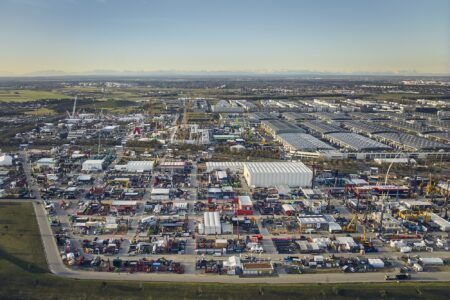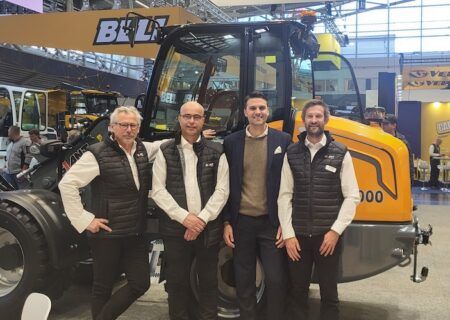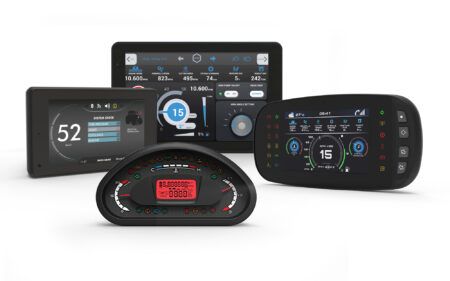Manitou Group, a worldwide reference in handling, aerial lift platforms and earthmoving, will present its new ultra-compact telehandler model at this year’s Bauma Munich in October. The launch confirms the group’s aim to offer its users ever more profitable and easy-to-use solutions.
To meet the needs of users who want a versatile machine that is easy to use and easy to transport between two worksites or farms, Manitou Group has designed a very lightweight model with a transportable weight of less than 3 tons, which can be loaded onto a trailer with a PTAC of 3,500 kg. This model was designed entirely by the design office at the Laillé (Ille-et-Vilaine) site, dedicated to producing “super compact” telehandlers for the group.
Its dimensions are among the most compact on the market with a width of just 1.49 m and a height of 1.92 m. This ultra-compact model comes in two versions with lifting capacity of 1.25 t and 1.5 t respectively for a lifting height of 4.30 m. Available in two versions for Manitou dealers: ULM 412 H and ULM 415 H for Ultra Light Manitou, but also for Gehl distributors with the GCT 3-14 and GCT 3-
Profitability
Targeted at a number of sectors, such as construction, agriculture and landscaping, this ultracompact telehandler enables users to work efficiently thanks to its rapid familiarization process and small size. It also enables artisan masons and landscapers to travel to their customers easily with a single trailer. This means machine transportation times are greatly reduced and user productivity is therefore more efficient.
A range of attachments specially designed for this model allows it to be used for more applications, providing users with even more options, such as forks carriages, hedge cutter, pot clamp, branch cutter, Big Bag handler and snow blade. Proving its usefulness on rough-terrain, this four-wheel drive telehandler has an oscillating rear axle, a wide range of tires and a very high ground clearance of 29 cm.
A number of innovative features help to reduce the total cost of ownership of this model. The Stop & Start option ensures a reduction of around €10 per hour idling of the machine’s TCO (reduced machine depreciation, fuel consumption and preventive maintenance). The capacity of the hydraulic tank is also reduced by around 25% thanks to the presence of an anti-emulsion filter. The hydraulic compensator is replaced by an electronic compensator, allowing the compensating cylinder to be dispensed with, thereby reducing hydraulic oil requirements and reducing the weight of the machine.
Removing the compensating cylinder also reduces the width of the truck, making it easier to move in tight spaces, particularly when entering farm buildings, loading straw bales, or maneuvering on renovation sites when handling pallets of cinder blocks or bricks, for instance.
Maintenance is also optimized with facilitated access to the main components of the engine thanks to the wide engine compartment opening. A hatch in front of the engine allows straw or dust near the radiators to be removed, and access to the fuel and hydraulic oil tanks is facilitated by their eye-level position. The Gehl and Manitou versions are of course connected as standard, and the user can completely manage maintenance via their smartphone thanks to the MyManitou and MyGehl apps.
Comfort and safety
The new ULM/GCT telehandler is designed to make handling operations even safer and more enjoyable. Access to the cab is easy with no added step. Inside the cab, the operator has an unobstructed 360° view to work safely.
Camille Rouvrais, product manager, says: “We worked with our design office to find an innovative solution that provides even more safety and comfort. We replaced the roof grille with a transparent, shock-resistant polycarbonate window, which complies perfectly with the requirements of the FOPS standard”.
The visibility improvements also apply to the operator’s lateral view. The side view is in fact very clear because of the position of the hydraulic hoses inside the boom and the engine cover positioned low down to the right of the operator. The user can also make use of driver assistance, with a screen on the dashboard displaying all the information needed for driving in the form of pop-ups. The joystick is positioned as standard on a floating armrest for more flexibility of use, and two vents are situated on the windshield for optimal demisting. For prolonged driving comfort, the group has also introduced an automatic parking brake and offers three steering modes: Two-wheel steering for traveling at high speeds; four-wheel steering for maneuvering in tight spaces; and crab mode for lateral maneuvers.





